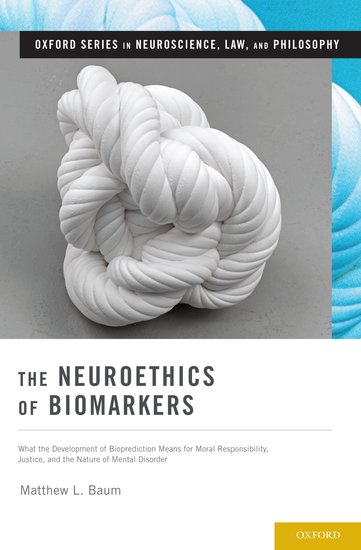Biomarkers have become an integral part of clinical practice in some spheres of neurology, such as dementia where they are enshrined in diagnostic criteria for Alzheimer’s disease as part of a clinico-biological (as opposed to an older clinico-pathological) definition of disease. The hope is that identification of disease in preclinical phases using predictive biomarkers may facilitate preventative treatment. But objections may be raised, for example to medicalising those who are currently well. The ethics of biomarker use in neurological and psychiatric disorders is explored in this volume by Matthew Baum, a Harvard MD-PhD trainee.
Addressing the bioprediction of brain disorder, the author argues for a reorientation of the medical concept of “disorder”, rejecting the old binary or categorical formulation (disorder/normalcy) in favour of a probabilistic model based on present and future risks of harm. This is justified in part by the belief, undoubtedly true, that “There is no a priori justification for believing that biomarkers will map cleanly onto diagnostic categories arrived at by historical accident” (p. 46). The result is a proposal for a “probability dysfunction” model in which disorders are conceptualised as graphs of probability over time, the area under which would help to separate out self-limiting disorders from those with low probabilities of harm over longer time periods.
“Risk banding”, based on the shape of the probability function, is the strategy advocated to determine the necessity or otherwise for response. This is illustrated with respect to bioprediction of future psychotic episodes and dementia (Chapter 5). This “risk of harm” approach is not seen as a fracture with past practice, since “Diagnosis is application of heuristic categories that capture a risk of harm associated with biological variation” (p. 125). The probabilistic claims of biomarkers may be used as a form of Bayesian updating. But will patients accept this reformulation?
This thought-provoking book will particularly appeal to those of a philosophical bent, rather than those who just want to know about biomarkers. It is not a book for dipping into during the interstices of the outpatient clinic, although the author must be commended for making the material accessible, his text is highly readable (and sometimes funny). Some clinicians will perhaps have little interest in the ramifications of predictive biomarkers for legal practice and societal distributive justice (when is biopredicted risk morally significant?), although even here there are interesting learning points: the discus- sion of prediction of seizures and driving is particularly pertinent. Furthermore, I was amazed to learn that in law the appeal to the “reasonable man” is regarded as an “objective” test, although the author rightly points out that this is almost always subjective in that it relies “almost exclusively on common sense and the persuasion of skilled law professionals to do this Bayesian updating” (p. 138). Whatever deficiencies there may be in medical (neurological) practice, at least we are attempting to put it on a research-based evidential footing.

